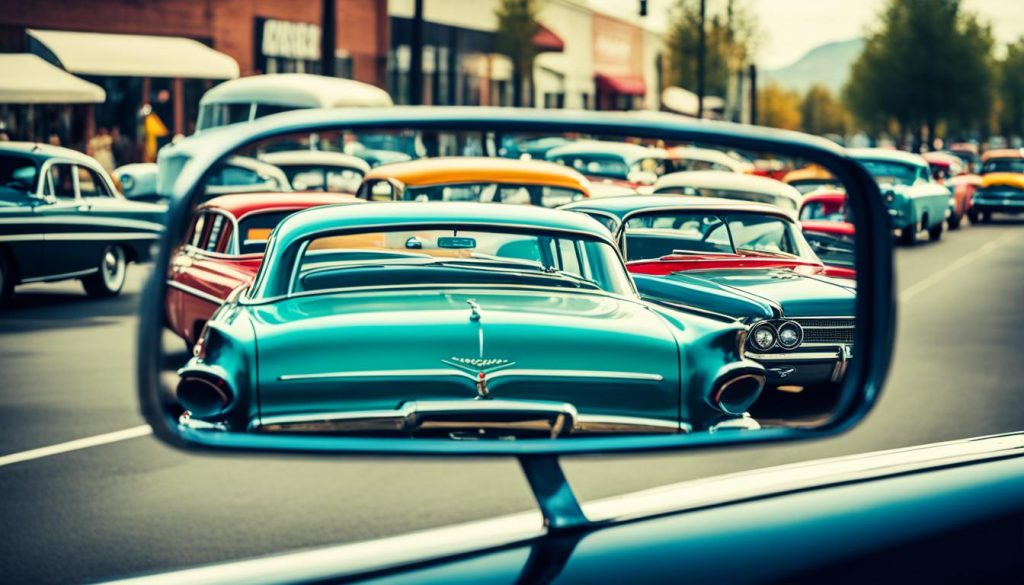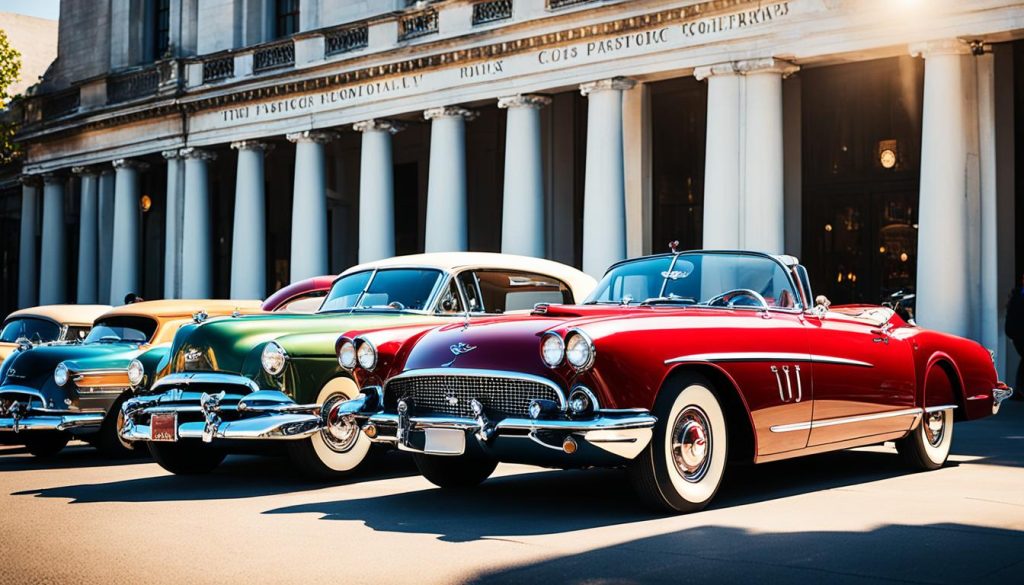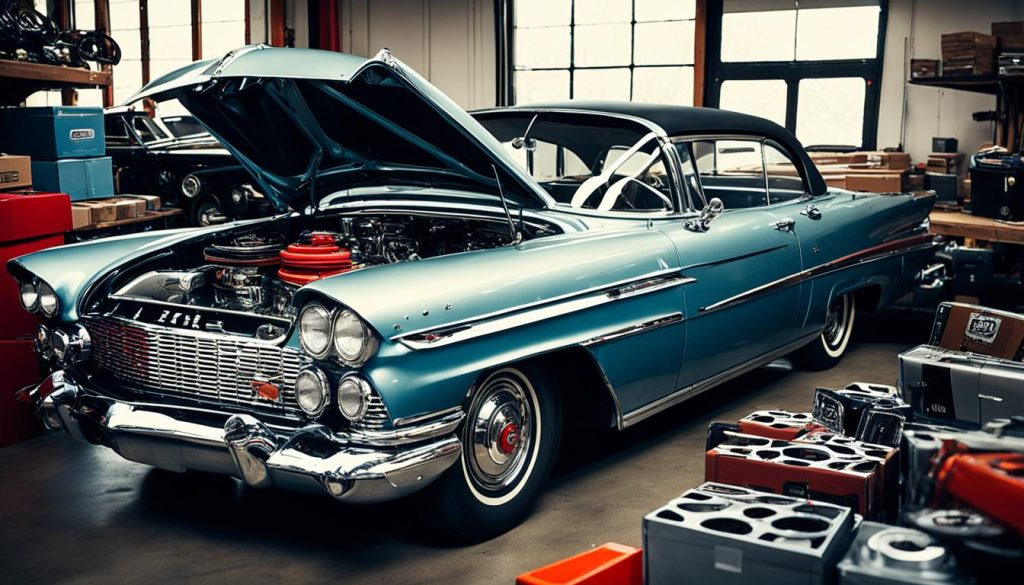The classic car market has grown a lot in recent years. The HAGI Top Index, which tracks vintage collectible cars, went up by 33.78% in 2019. It even rose 6.19% in 2020 and 2.73% in 2021, despite the pandemic1. High-end collectibles, which can be very expensive, have caught the eye of wealthy people. They see these investments as a way to diversify their portfolios.
But, investing in vintage cars has its risks. You’ll need to think about maintenance costs, where to store the car, and how it might lose value over time. This guide will look into why people love classic car investing. We’ll talk about the vintage car market and what makes a car collectible. We’ll also share insights on whether investing in vintage cars is a good idea and give tips for doing it well.
Key Takeaways
- From 2018-2023, collector cars had an average annualized return of 4.6%1.
- Classic cars that are rare, part of a limited production run, or unique are generally worth more1.
- Vintage cars can be a good investment depending on the type of car and its maintenance2.
- Rare and highly valued cars, especially previously owned by notable figures or featured in movies or pop culture, tend to appreciate more2.
- The market volatility of classic cars can be influenced by trends, economic conditions, and collector interest3.
- Is it worth investing in vintage cars?
- Classic car investments
- Antique automobile value
The Allure of Classic Car Investing
Classic car enthusiasts find joy in their prized automotive heritage4. Cars like the Ford Mustang, Chevrolet Corvette, and Porsche 911 have won hearts across the nation4. Rare models from brands like Rolls-Royce and Jaguar can reach millions of dollars, making them great for investing5.
Millions Involved in Car Collecting
Classic car investing is more than just making money5. It’s about the joy of car shows and clubs, celebrating the rich history of these cars5. These cars can be a smart investment, often beating stocks and bonds5.
High-End Collectibles for Diversifying Portfolios
High-end classic cars are a top choice for diversifying portfolios4. Only a few of these rare cars are made each year, making them highly valuable4. The HAGI Top Index shows the growing interest in classic car investing6. Recently, a 1934 Packard Twelve and a 1995 McLaren F1 set new auction records6.
Classic car investing is about more than just money5. It’s about keeping alive the love for these timeless cars546.
The Vintage Car Market Landscape
The vintage car market has seen a big rise, with the Historic Automobile Group International (HAGI) Top Index going up by 264.49% since December 20087. This shows the market’s strong growth. The Hagerty Market Index also hit a five-year high in December 2021, showing the classic car industry is doing well8.
At the top, rare cars from brands like Hispano-Suiza and Rolls-Royce have sold for over $1 million7. Even cars like the Toyota 2000GT are now worth over $1 million8. This shows how rare and unique cars can greatly increase in value.
Many factors have driven the demand for these cars. In Japan, the love for Western culture started in the late 20th century during a boom8. Cars made with luxury brands, like Lamborghini and Versace, have become collectibles worth a lot, from €149,500 to US$315,0007.
| Metric | Value |
|---|---|
| Classic Car Market Size | Around $450 million9 |
| Most Expensive Classic Car Sold | 1962 Ferrari GTO for $48.4 million9 |
| Classic Car Market Growth | 3.5% YoY since 20079 |
| Affordable Classics Index Growth | ~30% since 20159 |
| Blue Chips Index Decline from Peak | 14%9 |
Even though the vintage car market has grown a lot, it’s not always a steady investment. Stocks, bonds, and real estate usually give more predictable returns7. Classic cars are harder to sell because they are rare and need special care7.
Investing in vintage cars needs a lot of knowledge and money for upkeep and storage7. It’s a complex choice that comes with big risks. Investors should think carefully before starting a car collection7.
Qualities That Make a Car Collectible
Vintage cars with certain qualities are highly sought after by collectors and investors. Historically significant vehicles that led the way in technology or changed consumer expectations are often highly valued10. Cars that are rare and beautiful, have a racing background, and were owned by famous people also gain a special status11.
These cars are not just any cars. They are the ones that combine these qualities, making them highly desired by collectors and investors10. For example, a 1995 McLaren F1 sold for $20.465 million in 2021. A 1962 Ferrari 250 GTO went for $48.4 million in 2018, and another one was sold privately for over $70 million10. Cars with iconic automotive design, like the Shelby Mustang and Porsche 356, are also highly collectible when they are rare and in demand11.
It’s a rule that if a car was a dream for teenagers, it will be a sought-after collectible for them as they grow up10. This is why classic muscle cars from the 1960s and 70s, like the Shelby Mustang and Chevrolet Camaro SS, are so popular11.
| Vehicle | Year | Sale Price |
|---|---|---|
| 1962 Ferrari 250 GTO | 1962 | $48.4 million |
| 1995 McLaren F1 | 1995 | $20.465 million |
| 1954 Mercedes-Benz W196 Silver Arrow | 1954 | $29.7 million |
| 1934 Packard Twelve 1108 Dietrich | 1934 | $1.435 million |
In summary, historically significant vehicles, rare and beautiful classic cars, a racing background, celebrity ownership, and iconic automotive design are what make a car collectible and valuable101211.
Is It Worth Investing in Vintage Cars?
Potential Returns and Risks
Investing in vintage cars is exciting but also risky. Classic car values have soared, with a 500% increase from 2004 to 201413. Yet, the market’s future is uncertain. The collectible car market is expected to grow to $43.4 billion by 202414. But, making money depends on market trends, consumer tastes, and the economy14.
Buying vintage cars comes with big costs. Restoring a high-end car can cost as much as the car itself13. Selling it might mean paying commissions and fees13. Finding mechanics for old cars is hard, leading to high repair costs14. You also need secure storage to keep your car safe14.
Some cars, like the $30 million 1954 Mercedes-Benz, fetch huge prices13. But, only about 3% of classic cars make big profits at auction15. For beginners, cars in the $20,000 to $30,000 range are more affordable13. Still, there’s a risk that the car might not increase in value or could even lose value13.
Thinking about investing in vintage cars needs careful thought. Getting advice from a certified appraiser can help13. Doing your homework, understanding the risks, and knowing the market are key to success in classic car investing.
Tips for Successful Vintage Car Investing
Investing in vintage cars can be profitable if you plan well. Look for high-quality vehicles that could increase in value over time16.
It’s important to understand the vintage car market and what makes certain cars collectible. Some collectible cars have grown in value by 20% each year since 2007, beating the S&P 50016. The Classic Car Club of America calls cars from 1915 to 1948 classics16. Cars from 2000 or earlier that are 20 years old are considered modern classics, while those 45 years or older are vintage16.
Buy Quality and Understand Market Factors
Look for collectible vehicles that are rare, historically significant, or linked to famous designers or builders. These traits can help increase their value over time16. But, remember, restoring and keeping these cars costs money, and the market can be unpredictable17.
Successful vintage car investing requires careful analysis and a long-term view. Classic cars often lose half their value in the first five years, but collectibles can be an exception16. The value of classic cars depends on their age, condition, rarity, popularity, and brand16. Prices can drop during economic downturns, showing a link to financial markets16.
To profit from a classic car, it must have unique or limited edition features17. Cars over 15 years old with collectible qualities tend to keep their value well17. Making money from classic cars is tough unless the car stands out for its collectability17.
Classic cars need to almost double in value every 10 years to break even17. Investing in vintage cars should mix market analysis with personal enjoyment, as the returns can be unpredictable17.
Focus on quality, understand the market, and think long-term to succeed in vintage car investing18. Vintage cars gain value because they’re rare, and those with interesting histories or original parts sell for more18. Cars in great condition with authentic parts and few changes are more valuable18.
Classic cars have appreciated by about 193% in the last ten years, beating stocks and bonds18. By following these tips, you can enjoy the vintage car market and possibly earn both financial and personal rewards161718.
Conclusion
Investing in vintage cars can be rewarding for car lovers and those looking to diversify their investments. The classic car market has grown a lot lately, aiming to hit $43.4 billion in the U.S. by 202419. Over the last ten years, classic cars have done better financially than other collectibles like stamps or coins19. But, investing in vintage cars comes with risks like ongoing costs, possible depreciation, and unpredictable trends.
To succeed in vintage car investing, focus on cars that are high quality and historically significant. Rarity is key to a car’s value, with rare cars often having higher values and appreciating more20. Cars that are no longer made, limited editions, or famous movie stars are in high demand19. Know what makes a car collectible and be ready for restoration and maintenance costs. These cars usually cost less to maintain but can be expensive upfront21.
The love for automotive history keeps the vintage car market interesting and complex. Adding classic cars to your portfolio can reduce risk and possibly increase returns20. The classic car industry keeps its value, offering big potential returns. Classic cars also don’t closely follow traditional investments, making them a good choice for diversification20. When deciding to invest in vintage cars, let your love for these amazing vehicles guide you, not just the chance to make money19.
FAQ
Is investing in vintage cars worth it?
What makes a car a collectible investment?
What are the potential risks of investing in vintage cars?
How can I increase my chances of a successful vintage car investment?
What are some of the high-end collectible car brands?
FAQ
Is investing in vintage cars worth it?
Investing in vintage cars can be rewarding but requires careful thought. The classic car market has grown a lot lately, drawing in wealthy people wanting to diversify. Yet, owning vintage cars has its challenges, like upkeep, fixing, and storing them, and they might lose value. To succeed, do your homework, watch market trends, and think long-term.
What makes a car a collectible investment?
Cars that are historic, bring new tech, or set new standards can become collectibles. Being rare and good-looking helps too. A racing background, links to famous designers, or past celebrity owners also boost their appeal. The best collectibles mix these traits, making them popular with collectors and investors.
What are the potential risks of investing in vintage cars?
Vintage cars have their risks and challenges. They might not always go up in value, and owning them costs money for upkeep, fixing, storing, and insuring. Buying a car that doesn’t gain value or even loses it is a risk. Fixing a high-end collectible car is costly, and selling it means paying commissions and fees.
How can I increase my chances of a successful vintage car investment?
For a successful vintage car investment, focus on buying cars in good shape with a good chance of going up in value. Know the market, what makes a car collectible, and the costs of owning one. Cars with a history, rarity, or links to famous designers or builders are good bets. But remember, fixing and keeping these cars costs a lot, and market trends can change.
What are some of the high-end collectible car brands?
High-end collectibles include rare models from Rolls-Royce, Jaguar, and Hispano-Suiza, priced in the millions. These cars are sought after by the wealthy for their investment potential. Even cars from lesser-known brands like Toyota’s 2000GT can fetch over
FAQ
Is investing in vintage cars worth it?
Investing in vintage cars can be rewarding but requires careful thought. The classic car market has grown a lot lately, drawing in wealthy people wanting to diversify. Yet, owning vintage cars has its challenges, like upkeep, fixing, and storing them, and they might lose value. To succeed, do your homework, watch market trends, and think long-term.
What makes a car a collectible investment?
Cars that are historic, bring new tech, or set new standards can become collectibles. Being rare and good-looking helps too. A racing background, links to famous designers, or past celebrity owners also boost their appeal. The best collectibles mix these traits, making them popular with collectors and investors.
What are the potential risks of investing in vintage cars?
Vintage cars have their risks and challenges. They might not always go up in value, and owning them costs money for upkeep, fixing, storing, and insuring. Buying a car that doesn’t gain value or even loses it is a risk. Fixing a high-end collectible car is costly, and selling it means paying commissions and fees.
How can I increase my chances of a successful vintage car investment?
For a successful vintage car investment, focus on buying cars in good shape with a good chance of going up in value. Know the market, what makes a car collectible, and the costs of owning one. Cars with a history, rarity, or links to famous designers or builders are good bets. But remember, fixing and keeping these cars costs a lot, and market trends can change.
What are some of the high-end collectible car brands?
High-end collectibles include rare models from Rolls-Royce, Jaguar, and Hispano-Suiza, priced in the millions. These cars are sought after by the wealthy for their investment potential. Even cars from lesser-known brands like Toyota’s 2000GT can fetch over $1 million, showing the variety in vintage cars.
million, showing the variety in vintage cars.
Source Links
- Are Classic Cars a Good Investment?
- How Your Vintage Car Can Be an Investment | Hagerty
- Are Classic Cars A Good Investment? – Neighbor Blog
- Classic vs. Exotic: Which Type of Car Should You Invest In?
- The Value of Classic Cars: A Timeless Investment for Enthusiasts
- The Allure and Intricacies of Investing in Classic Cars | GDL Automotive | Mechanic Hornsby & Warriewood
- Are classic cars a good investment?
- Road to Wealth: Connoisseurship In Classic Car Investing
- Investing In Classic Cars And More With Rally – Alts.co
- Investing in Collectible Cars: Top Tips and Risks
- Best Cars To Buy As Investments
- Vintage Car Investing | Classic Recreations
- Investing in Classic Cars – Nationwide
- Pros and Cons of Investing in Classic Cars
- Are Classic Cars a Good Investment? – Dusty Cars
- How to Invest in Classic Cars – MoneyMade
- Are classic cars worth investing in?
- Investing in History: The Financial Benefits of Owning Vintage Cars
- Facts You Should Know About Classic Car Investment
- Why Buying Classic Cars Is A Great Investment In 2023? | NTS
- Why Vintage cars are the best?



